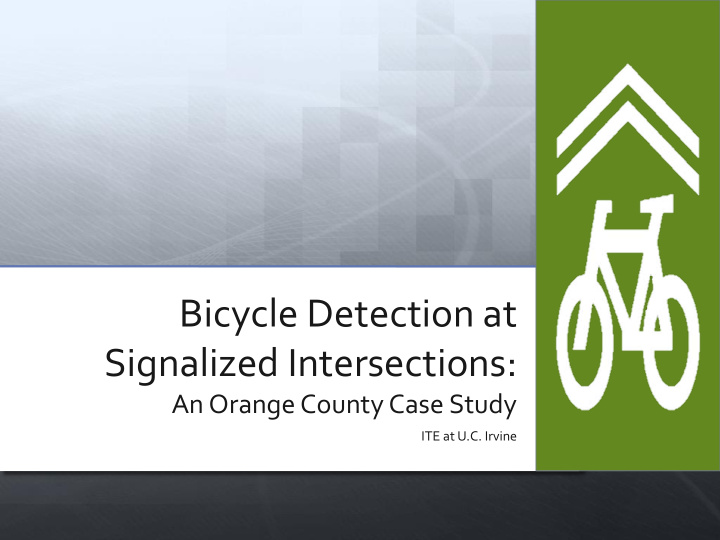



Bicycle Detection at Signalized Intersections: An Orange County Case Study ITE at U.C. Irvine
2 Problem Definition Goal: Understand how to better integrate bicycling as part of the overall transit system. Provide limit line detection for bicycles Or Place the signal on a permanent recall/fixed time.
3 Overview How are cities approaching the problem? Detection case study Users’ perspective Conclusion & next steps
4 City Traffic Engineer Reviews 100% 95% 100% 90% 81% 80% 71% State of the Practice 70% 60% 50% ₊ Goal: Understand what is currently 40% being done 30% 20% 10% ₊ Developed detailed survey to 0% identify what cities are currently ILD (10) Video (9) Push Radar (1) using. Button (7) ₊ Contacted 34 cities ₊ 20 completed surveys
5 The State of the Practice
6 Detection Case Study – Set-up Goal: Test how well current detection technologies work. Collaborated with the City of Anaheim to test three different technologies: Iteris, Inc. (video detection) Econolite Group (video detection) Reno A&E (inductive loops) Analyzed 17 hours of data Collected data on Saturday, May 9 th , 2015 from 4am-9pm
7 N Southbound approach on Lakeview Avenue & Riverdale Avenue 7
8 Iteris, Inc. Video Detectors 8
9 Econolite Group Video Detectors 9
10 Reno A&E Loop Detectors 10
11 Detection Case Study – Set-up BICYCLE DETECTION DIAGRAM Anaheim ANAHEIM TMC TMC Ethernet Axis AXIS VIDEO ENCODER ETHERNET SWITCH video switch encoder NEMA NEMA TS-1 DETECTOR PANEL Cabinet 22 GAUGE AWG COAXIAL CABLE ETHERNET
12 Detection Case Study - Results Detection: Any individual bike successfully Sample Size: 55 Bikes identified by the technology. 𝐸𝑓𝑢𝑓𝑑𝑢𝑗𝑝𝑜 𝑆𝑏𝑢𝑗𝑝 = 𝑂𝑣𝑛𝑐𝑓𝑠 𝑝𝑔𝐸𝑓𝑢𝑓𝑑𝑢𝑗𝑝𝑜𝑡 Missed Detection: Any individual bike not 𝑇𝑏𝑛𝑞𝑚𝑓 𝑇𝑗𝑨𝑓 identified by the technology. Missed Detections Detection Ratio Detections Iteris, Inc. 3 52 95% (video detection) Econolite Group 1 54 98% (video detection) Reno A&E 10 45 82% (loop detection)
13 User Perspective Goal: Understand steps of Understand Understand holistic success Cities’ Users Approaches Surveyed 4 recreational groups, 2 commuter groups, 3 mixed groups Understand Technologies
14 User Perspective Previous knowledge of bike detection from self education and personal experience Skeptical of the overall improvement of bicyclists’ experience on the road with the addition of bicycle detection More information is needed to better educate both bicycle users and cities.
15 Conclusions & Future Analysis • Cost analysis • Different site conditions • Varying bicycle densities More Data • More technologies • View users as active participants for feedback and improvement. Education and Outreach • Bicycle detection is only part of the overall solution. Combine Research
Acknowledgments The City of Anaheim John Thai, Principal Traffic Engineer Participating Companies Iteris, Inc Econolite Group Reno A&E Participating Survey Respondents 16
17 Summary and Review Objective: Better integrate bicycling as part of the Detection Ratio existing transportation 100% 98% system. 95% 95% Results: Bicycle detection 90% technologies work and play a 85% key role, but more factors are 82% 80% required to fully integrate bicycles into the 75% transportation system. 70% Iteris, Inc. (video Econolite Group (video Reno A&E (loop detection) detection) detection) More information at: https://itechapteruci.wordpress.com/
Recommend
More recommend